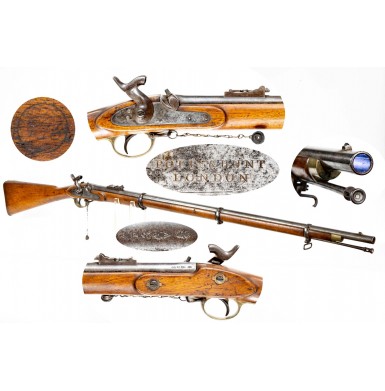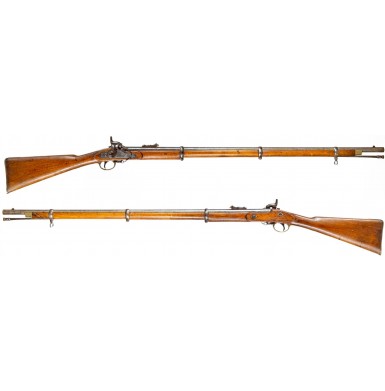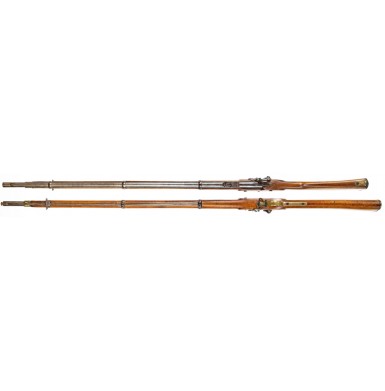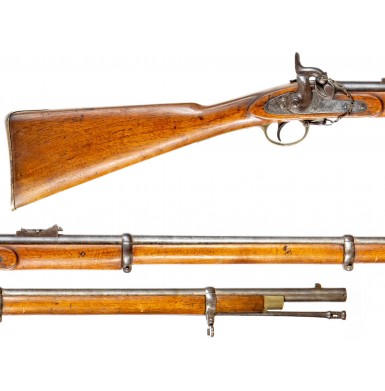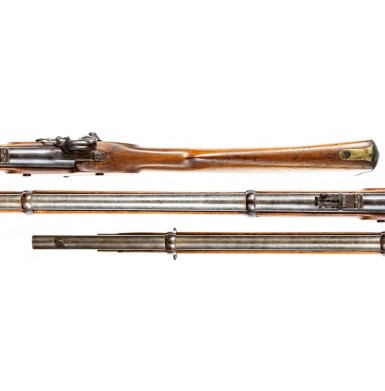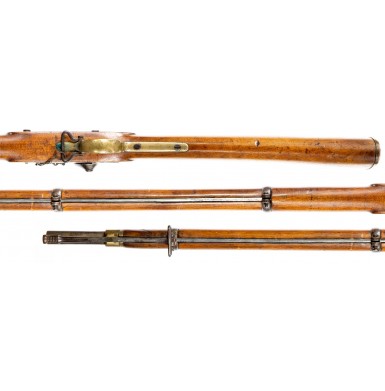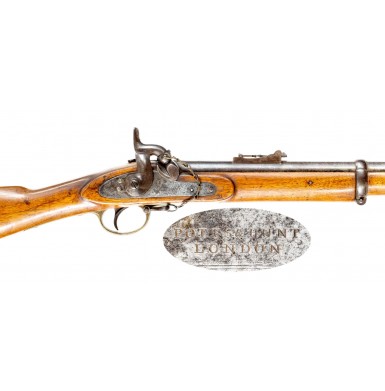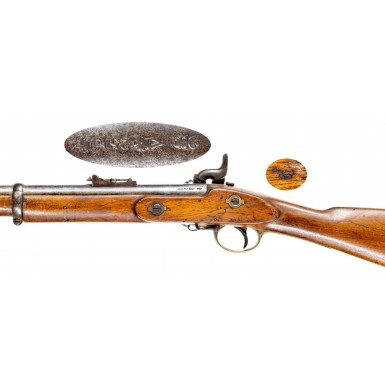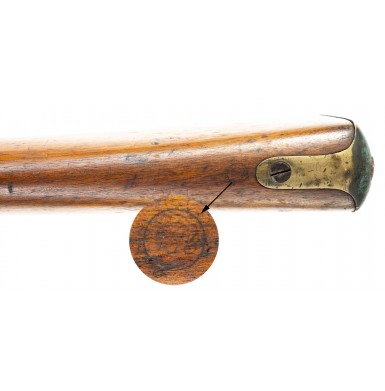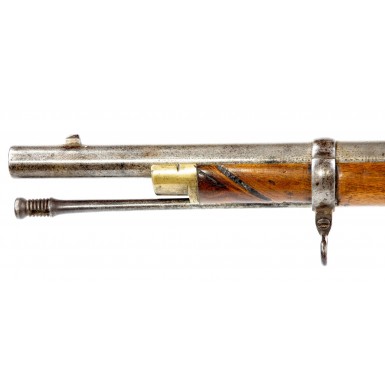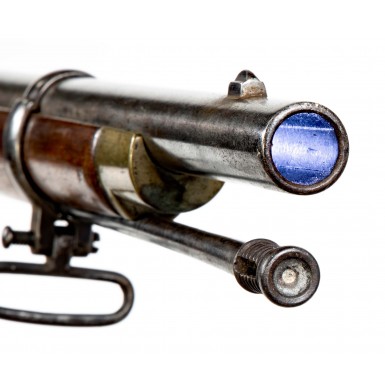Confederate Marked Pattern 1853 Enfield Rifle Musket by Potts & Hunt
- Product Code: FLA-3707-SOLD
- Availability: Out Of Stock
-
$1.00
The Pattern 1853 “Enfield” Rifle Musket is often noted as being the second most used long arm on both sides during the course of the American Civil War. While Confederate marked Enfields are highly sought after by collectors, US purchased Enfields are often difficult to specifically identify, as they do not appear to have been marked with the myriad of inspection marks noted on the various Confederate imported arms. As such, commercial export Enfields without British military markings (from both Birmingham and London) are often generically thought of as “US imports”. According to Ordnance Purchases Document 99, the US Ordnance Department purchased 505,135 Enfield Rifle Muskets between 1861 and the close of import arms purchases in mid-1863. This number does not include the Enfields purchased by northern states such as New York, New Jersey and Massachusetts.
One of the London based arms makers that has always had a strong Civil War association was the firm of Potts & Hunt. The firm of Potts & Hunt was established in London at 27 Tenter Street East in 1854. The firm could trace its gunmaking lineage to Thomas Potts, who operated from 1828-1847 and was succeeded by Thomas’ son, Thomas Henry Potts in 1848. In 1854, Thomas H Potts and Thomas Hunt formed a partnership known as Potts & Hunt, and that partnership remained in business through 1867, when the partners split up and went their own ways. It appears that much of Potts & Hunt’s commercial production of Enfield rifle muskets (manufactured in the early 1860s) was sold to US buyers during the course of the American Civil War. Even William B Edwards noted in Civil War Guns that “While Potts & Hunt are characterized by Albaugh as “probably Confederate”, Colt was a contractor with Potts & Hunt and more likely the Potts & Hunt Enfields in the Civil War came to the North through Colt.” Colt had developed his relationship with the firm during his time operating his London manufactory. At the outbreak of the war, Colt had explored obtaining gun barrels for use in his US contract rifle muskets from the English gun trade. These 40” long variants of the P1853 Enfield barrel were marked with a <C> “Diamond C” at the breech. The Ordnance Department refused to accept these barrels on US M1861 contract rifle muskets, and Colt subsequently sold those barrels back to the English gun trade, where some ended up being used to assemble Confederate contract Enfield rifle muskets! It is generally believed that Potts & Hunt provided Colt’s entrée into the English gun trade and probably helped him make arrangements to buy, and later sell, the barrels through some of the Birmingham based suppliers.
In 1861, Colt received a contract to deliver 10,000 “Long Enfield rifles” at the rate of $22.50 per stand to the US Ordnance Department. Colt also received a contract to deliver 2,000 “Short Enfields w/ sword bayonet” at the rate of $25.00 per stand. However, Colt delivered just under half of those 12,000 long guns. The Colt Patent Firearms Company delivered only 3,120 “Long Enfield rifles w/bay.” and “1,940 Short Enfield rifles, saber bayonet” to the US Ordnance Department as a result of the 1861 contract. It is generally assumed that the 3,120 “Long Enfields” were sourced from Potts & Hunt. Of course, Colt was not the only buyer to obtain Enfields from Potts & Hunt, as the company sold the guns to all willing buyers on both sides of the conflict. Colt does, however, have a very strong association with the company.
Potts & Hunt Enfields also appear with Confederate inspection and importation markings as well. While some have the better known viewer marks like the {CROWN} / SH / G# or the {Anchor/S}, none are known with the engraved inventory number and JS / {ANCHOR} inspection mar that is associated with the second Sinclair, Hamilton & Company contract with the Confederate central government for 30,000 Pattern 185 Enfield Rifle Muskets. The Confederate acquired Potts & Hunt guns often bear one of the lesser known Confederate inspection marks, which are also found on some Barnett arms like a small script or block JS in a circle, a small SL in a circle or even a JH in a circle; just to list a few. All of these marks are found on the comb of the stock, forward of the buttplate tang, and are approximately the same size as the well-known CH / 1 Barnett mark.
The CH / 1 mark typically encountered on Barnett arms has been documented through the papers of Confederate General Colin J. McRae as being that of the arms “viewers” Isaac Curtis & Charles Hughes, who inspected Confederate purchased arms for Barnett. It is logical to believe that these other marks are also Confederate inspection marks, with the “JS” marks likely being John Southgate’s mark, with the “SL” and “JH” being the initials of yet to be identified Confederate inspectors. I have come to the conclusion that because the marks used by the “viewers” of those arms purchased by the Confederate central and state governments are relatively well documented within the McRae Papers, the marks that have yet to be fully identified may represent speculative southern purchases. Speculative purchases were those items that were acquired “on speculation” that they would find a ready market when they were offered for sale in the Confederacy. Every blockade runner reserved part of its cargo space for such purchases that ranged from the European luxuries that were selling for exorbitant prices in the south during the war like high end fabrics and perfume, to much more mundane items like pins, needles and shovels; all items that were difficult to obtain in the south during the war. These items were easily obtainable in England for reasonable prices and could be sold for huge profits in the Confederacy. These profits made the risks and expenses of operating as a blockade runner much more attractive then it would be if the ship owners and captains were simply delivering items for the Confederate government. Due to the wide variety of yet to be fully understood inspection marks on the combs of Enfield stocks that typically involve initials, I feel that it is as likely that some of the marks may reference the buyer or speculative investor as often as they refer to the inspector who viewed the arms. Further research may finally reveal more of the secret of these enigmatic Confederate markings.
Offered here is a VERY GOOD condition example of a commercial Pattern 1853 Enfield Rifle Musket produced by the London firm of Potts & Hunt that has one of the enigmatic and yet to be identified Confederate inspection marks on the stock comb, in front of the buttplate tang. The mark is the expected small circle that appears to contain the initials JH, although the marking is weak and not fully legible. The lock of the gun is clearly marked in two horizontal lines, forward of the hammer: POTTS & HUNT / LONDON. The lock has no other external markings but does have the traditional double boarder line engraving around the outer edge of the lock. In a completely non-scientific analysis of extant examples of Potts & Hunt produced Enfield rifle muskets, it has been found that the many of the Potts & Hunt guns with southern or Confederate markings and attributions do not have this boarder line engraving, while most of the examples with the border line engraving that have any sort of markings or attribution have a Yankee association. The reasons for this are unknown, but it could be speculated that the non-engraved lock was minutely cheaper, which provided a noticeable saving across the purchase of thousands of arms. However, as I have noted more than once, when it comes to Civil War used Enfields, “never say never” is a good watch word as even strong trends do not always hold consistently. This Confederate Potts & Hunt does have boarder line engraving. The hammer is the traditional “London style” hammer without the engraved “feathers” on the nose, but which has matching boarder lines engraved on the hammer body.
The interior of the lock is marked P&H over the mainspring and has no lock maker’s mark at the mainspring boss stud. The top edge of the lock plate bears the assembly mating mark \ \ / | | | |. This same mating mark is found throughout the gun, including the lock mounting screws, the breech plug tang screw, under the barrel and in the ramrod channel. The left breech of the barrel is marked with the usual three London commercial proof, view and definitive proof marks, along with the gauge mark 25, which indicates .577 caliber. On London proved guns, the gauge mark is often found under the barrel instead of on the breech. The bottom of the barrel has the matching mating mark \ \ / | | | |, and shows the usual assortment of maker, assembly and inspection marks. These include a P&H mark for Potts & Hunt, the initials JM and the name of the Birmingham barrel maker who supplied the rough barrel, EZRA MILLWARD. The ramrod channel has the matching mating mark throughout the balance of the gun.
The gun has a lightly mottled and oxidized brownish patina developing over a mostly dull, pewter gray barrel. The thickest area of oxidation is around the breech of the barrel and is thinner and more mottled on the exposed portions of the metal, with the barrel having a smooth pewter patina under the bands and under the barrel where the stock has protected the metal. The lock has a similar, although thicker mottled brown patina. The metal is mostly smooth with some scattered patches of surface oxidation, pinpricking and some light pitting which is mostly found around the breech and bolster area. The bore of the gun is in about VERY GOOD condition, with an evenly oxidized and frosted brownish-gray patina and strong visible rifling along its entire length. The bore also shows some scattered patches of light pitting here and there. The lock of the gun functions perfectly and operates crisply on all positions. The gun retains its original long-range rear sight and the combination front sight/bayonet lug. Two of the three of the barrel band tension screws retain their original round screw keepers on the ends, with the lower band missing this part. These tiny pieces are often found missing from Enfields that survive today. The gun retains both of its period sling swivels. An original jag-head Enfield ramrod is in the channel under the barrel. It full-length and has good threads at the end. An original, period snap cap (cone protector) is in place, suspended from the correct pattern iron split ring that is attached to the lower sling swivel. The protector has the correct pattern chain and the original iron base with only traces of the leather pad remaining. The brass furniture has a thick, uncleaned patina with dark ocher, brown and some dark greenish tones. The stock of the gun is in about VERY GOOD condition as well. The stock is solid, full-length and complete and is free of any breaks or repairs. The stock has a nice, uncleaned look with the appearance of burnished wood that reminds one of a banister rubbed by thousands of hands over many decades of handling. The overall appearance is really very attractive, and the patina of the wood matches the metal wonderfully. The stock shows numerous scattered bumps, dings and marks from service, handling and use, but still retains good edges and strong lines. There is no real indication that the stock has been sanded. The only real stock condition issues worth noting are a couple of small chips of wood missing, one at the rear of the breech plug tang, and one at the left of the tang where it meets the breech of the barrel. Both are fairly old, as the chips show wear and age, and are the result of improper removal of the barrel from the stock. There is also a surface scar between the upper band and nose cap on the reverse of the stock. While it is impossible to know what caused this minor damage, a romantic notion might be that the gun was damaged while the soldier using it was deflecting a saber blow from a cavalryman.
Overall, this is a very attractive, relatively crisp, 100% period complete and correct Confederate Purchased Pattern 1853 Enfield Rifle Musket by the well-known London gun making firm of Potts & Hunt. This is a straight commercial gun that never saw British military service and has a reasonable, if weak, Confederate inspection on the comb of the stock. Every collection of Civil War arms needs at least one Enfield rifle musket, and this has a very nice look that displays well, has no glaring condition issues and is very fairly priced for a southern gun.
ON HOLD
Tags: Confederate, Marked, Pattern, 1853, Enfield, Rifle, Musket, by, Potts, &, Hunt

